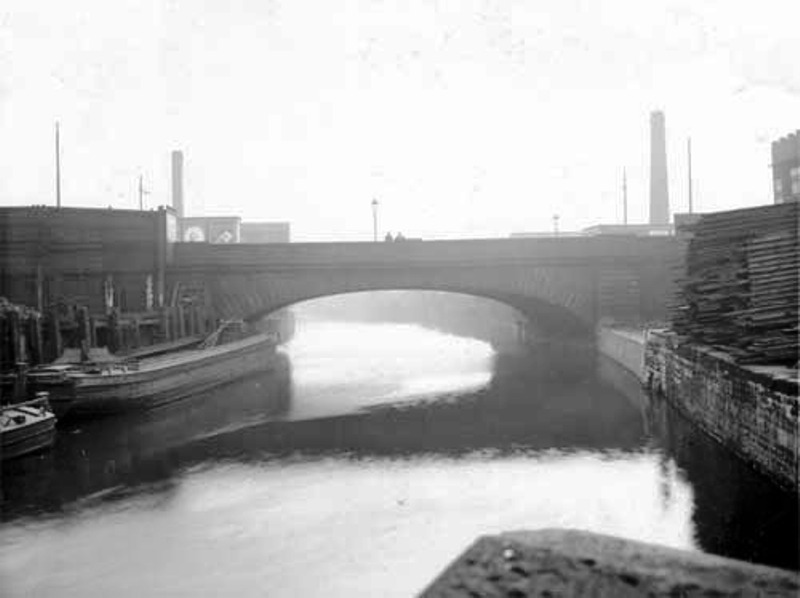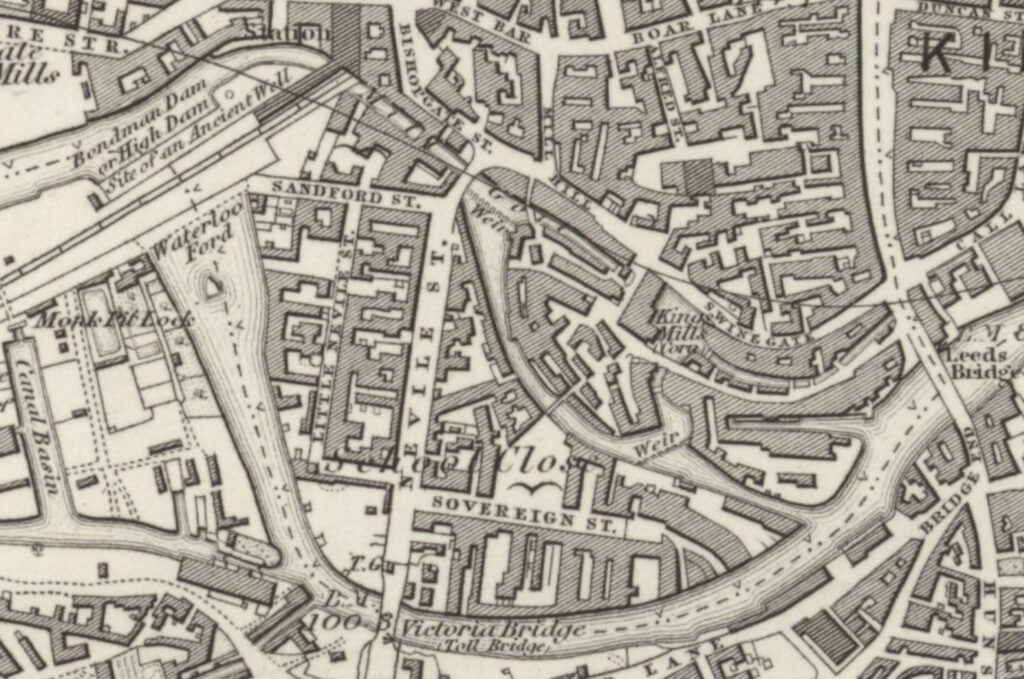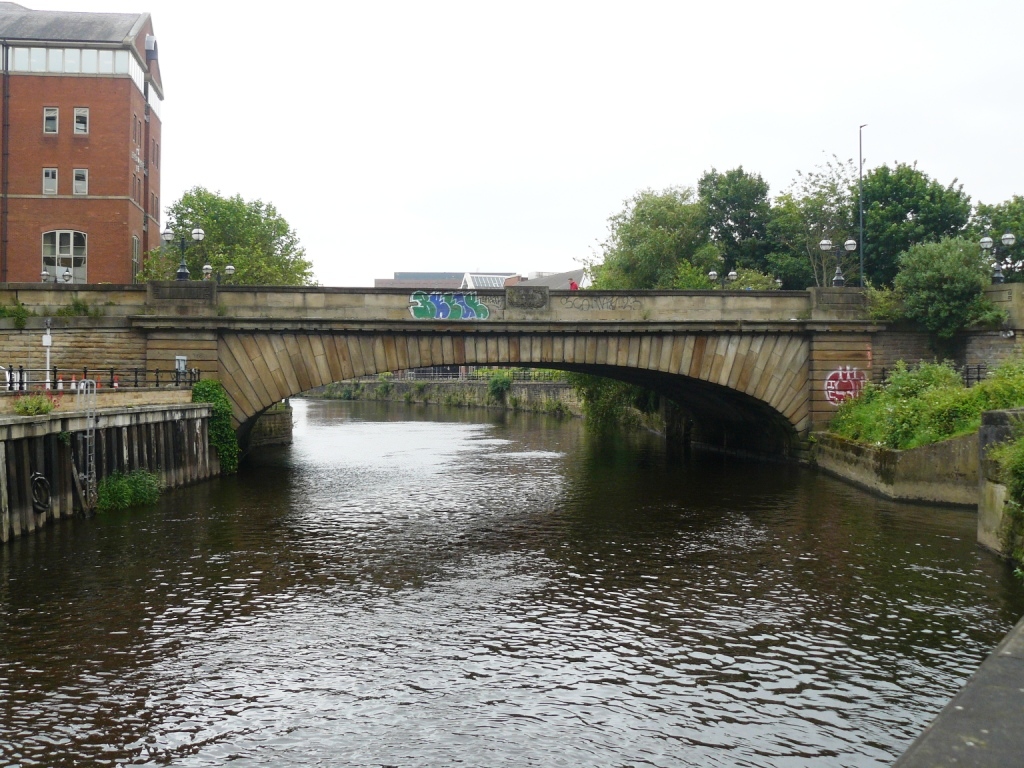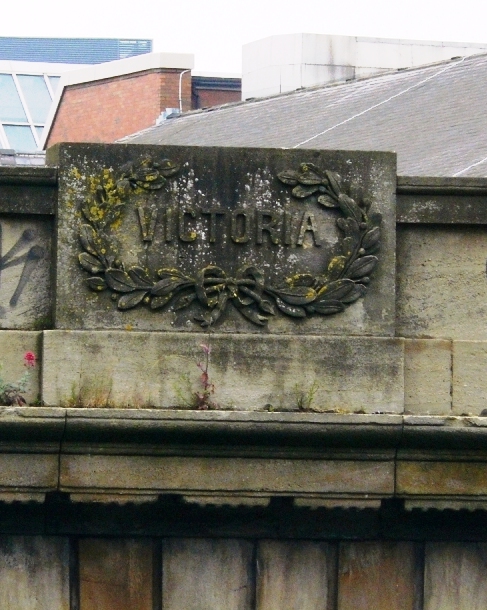
Having completed Wellington Bridge (June) and Monk Bridge (July) our next bridge is a short walk down the Leeds & Liverpool Canal towpath to the Canal Basin where we will find Victoria Bridge situated.
The planning and construction of this bridge was a very long and drawn out affair that continued for almost 20 years, before it was decided it was an important connection that needed to be made to connect South Leeds with the populous North side of the river.
It was intended to connect School Close (Neville Street) and Water Lane. At this point there was a ford, latterly known as Waterloo Ford; there were also stepping stones across the river and a ferry. The river at this location was a very popular place for washing horses, stage coaches, chaise, and carriages. It was normally quite safe but in winter when the river was swollen by heavy rain it was dangerous and there are several accounts of people and horses being swept away and drowned. There was a very short lived footbridge at this point erected by a Mr Hill in June 1819 but after objections from the Leeds & Liverpool Canal Company it was pulled down on 18 October 1819.

This bridge was followed by a temporary “Union Bridge” which created more pomp and ceremony than any other bridge over the River Aire in Leeds. This was the forerunner of the School Close Bridge and was an elliptical shape of 72 foot span and 7 feet 6 inches wide of timber construction. The construction of this bridge commenced on 6 July 1829 and it opened on 18 September with a brass band and a procession from the Court House in Park Row down Bishopgate Street and Neville Street to the New Bridge and, it is said, attended by several thousand people.
There was a suggestion for a permanent bridge and there were many meetings but the scheme seemed to suffer from insurmountable problems, both financial and other matters, and on 7 February 1824 it was abandoned.
During 1835 and 1836 meetings were held to revive the proposed bridge and in February 1836 an Application was made to Parliament and on 19 May the Act received Royal Assent and gave authority for the formation of a Company to build the bridge.
In December 1836 it was decided to call it the Victoria Bridge and the Company was to be the Victoria Bridge Company. An interesting point to comment on here is that Queen Victoria had not acceded to the throne until 20 June 1837 and was not crowned until 28 June 1838. It may be the Company had gifted foresight.
The Civil Engineer for the bridge was George Leather & Son of Leeds and contracts were let on 13 January 1837 for a bridge costing £8,000 with one arch of 80 foot span and a width of 45 feet between the battlements and a toll house at the side, the successful contractor for this was Mark Flavell & Sons.
The bridge is a neat structure of the Doric order with an elliptical masonry arch with what could perhaps be called ‘Sunrise’ voussoirs. That is to say that it’s facing stonework is arranged in a radial pattern making it look an attractive bridge. Construction began in the February and on 10 May 1837 the Foundation Stone was laid be George Goodman who was also responsible for laying the Keystone for the arch on 27 March the following year.
On 21 December 1837 disaster struck after two or three days of extremely heavy rain produced one of the highest and most sudden floods in Yorkshire. In Leeds, Water Lane, School Close, Meadow Lane, and Ladybridge, Lady Lane suffered the most.
The streets were rendered impassable with water in some areas four or five feet deep while the water level in Marshall’s Mill was some thirteen inches above the level in Water Lane and much damage was done to property in the vicinity of the flood. The temporary footbridge (Union Bridge) was forced down by an immense iron boiler that floated against it and both were driven against the framework on which the arch was built but fortunately unlike the bridge it withstood the pressure.
In May 1838 a Special General meeting was held to raise a further £8,000 towards the completion of the bridge; the bridge being completed at the end of 1839. The beginning of January 1840 saw the bridge and its approach roads open and tolls being taken. The approach roads were Victoria Road from the bridge to Dewsbury Road and Wilson Street from the bridge to Hunslet Lane and the diversion and raising of the approach from Water Lane, these road works were designed by Charles Fowler an engineer of Leeds. The history of the bridge as a turnpike was uneventful and on 1 February 1867 all tolls were removed.
The bridge is still in full use today in spite of the massive increase in traffic of all types and sizes.

While you’re here, can we ask a favour?
South Leeds Life is published by a not-for-profit social enterprise. We keep our costs as low as possible but we’ve been hit by increases in the print costs for our monthly newspaper which have doubled in the last two years.
Could you help support local community news by making a one off donation, or even better taking out a supporters subscription?
Donate here, or sign up for a subscription at bit.ly/SLLsubscribe



